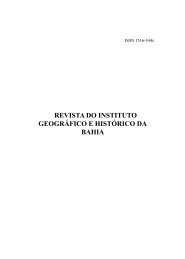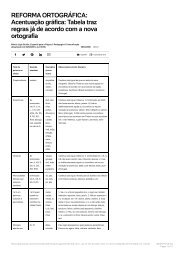You also want an ePaper? Increase the reach of your titles
YUMPU automatically turns print PDFs into web optimized ePapers that Google loves.
Downloaded by [University of Illinois at Urbana-Champaign] at 06:35 10 March 2015
PORTUGUESE ROTEIROS, I 500-I700
and made it move." Commander da Costa observes that here
we have the deviation of the needle noted I 28 years before it was
vaguely suggested by Denis of Dieppe.
2. Because the needle varied when the ship was close to the
shore off the bar of Bassein river, he concluded that this was
due to "these rocks being of the same sort and substance as that
of the magnet," which is the phenomenon of local attraction
verified in the distant sixteenth century. In addition, his
descriptions of meteorological phenomena, such as the water
spout and halo, are of an astonishing accuracy, whilst his observations
on coastal navigation leave nothing to be desired in
precision, as the following extract, relating to the crossing of
the bar of Bassein river, will serve to show:
and of the bank and flats within the river, very close to the shore on the south side
and off a prominent tongue of land, lies a great heap of black stones, which are
visible at low tide and disappear from view at high tide. Along this heap of stones
is situated the deepest and most frequented channel, which is used when entering
the river or port. This channel I sounded with my own hand at low-tide one
morning, and I found I! fathom of water on the bank. Before we get clear of
these banks, going along the channel, on one side there is a crown-shaped rock at
a depth of one fathom, and when we are over it, the island will lie to the North
quarter of the North East, and one of the four islets to the South quarter of the
South West. Once this bank is passed, the depth increases rapidly, and at once
we find three and afterwards four and further on five fathoms, and in some places
six, and so it goes until we get close to the prominent tongue of land which I said
was projecting from the shore of the south bank of the river.
The maps which accompany the descriptions of his voyages
to Diu and the Red Sea are veritable hydrographic charts, most
remarkable considering that they were drawn up in an era when
such were unknown.
Dom Joao de Castro's talents did not pass unnoticed in his
own day. The famous Spanish cosmographer, Alonso de Santa
Cruz, took special pains to meet him when he visited Lisbon
in I545, whilst our own Sir Walter Raleigh purchased the
original of Castro's Red Sea Roteiro, for the sum of £6o (a
colossal price for those days), it being published in translation
by Purchas in his Pi/grimes more than 200 years before its first
printed appearance in its native tongue 1 •
I Purchas also says that the original was dedicated to the Infante Dom Luis,
and that Sir Walter Raleigh had added numerous marginal notes and observations.


![[Cortar & Editat] Artigo - BOXER, C.R - Portuguese Roteiros, 1500-1700_removed](https://documents.yumpu.com/000/065/314/939/2e145b8f9d020cb1478f6bb669de4b853369b67c/574b7158624e37784b6d445a4f59594f6444506d52673d3d/6d68336239437068725051696641665069454b4150773d3d.jpg?AWSAccessKeyId=AKIAICNEWSPSEKTJ5M3Q&Expires=1717606800&Signature=1fPEEqaYYBc9AY5pCVWceXMPQss%3D)

![[Capa & Editar] Artigo - BARROS, Sigrid Porto de - A](https://documents.yumpu.com/000/063/816/786/af709ce29d1c721e5f74c145faeb760c1556c101/714f48715a616a2f324a556f537178394e6b4b4f54413d3d/45394b5a5354347734556b4a575634636c39565037413d3d.jpg?AWSAccessKeyId=AKIAICNEWSPSEKTJ5M3Q&Expires=1717606800&Signature=%2FBnY5NFk2xHNrS%2Bwpa7tbDYYFOo%3D)



